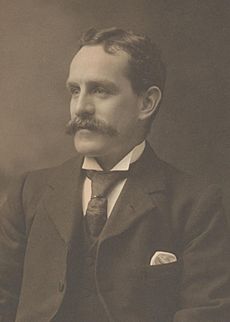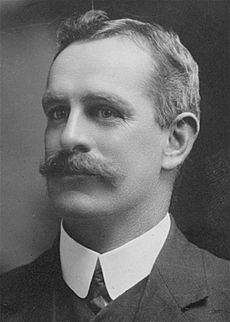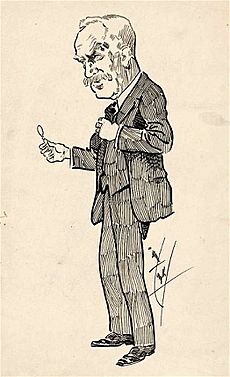Frank Tudor facts for kids
Quick facts for kids
Frank Tudor
|
|
|---|---|
 |
|
| 6th Leader of the Opposition Elections: 1917, 1919 |
|
| In office 17 February 1917 – 10 January 1922 |
|
| Prime Minister | Billy Hughes |
| Preceded by | Joseph Cook |
| Succeeded by | Matthew Charlton |
| 4th Leader of the Labor Party | |
| In office 14 November 1916 – 10 January 1922 |
|
| Deputy | Albert Gardiner |
| Preceded by | Billy Hughes |
| Succeeded by | Matthew Charlton |
| Minister for Trade and Customs | |
| In office 17 September 1914 – 14 September 1916 |
|
| Prime Minister | Andrew Fisher Billy Hughes |
| Preceded by | Littleton Groom |
| Succeeded by | Billy Hughes (acting) |
| In office 29 April 1910 – 24 June 1913 |
|
| Prime Minister | Andrew Fisher |
| Preceded by | Robert Best |
| Succeeded by | Littleton Groom |
| In office 13 November 1908 – 2 June 1909 |
|
| Prime Minister | Andrew Fisher |
| Preceded by | Austin Chapman |
| Succeeded by | Robert Best |
| Member of the Australian Parliament for Yarra | |
| In office 30 March 1901 – 10 January 1922 |
|
| Preceded by | Seat created |
| Succeeded by | James Scullin |
| Personal details | |
| Born | 29 January 1866 Williamstown, Victoria Colony, British Empire |
| Died | 10 January 1922 (age 55) Richmond, Victoria, Australia |
| Political party | Labor |
| Spouses |
Alice Smale
(m. 1894; wid. 1894)Fanny Mead
(m. 1897) |
| Children | 6 |
| Education | Richmond Central State School |
| Signature | |
Francis Gwynne Tudor (born January 29, 1866 – died January 10, 1922) was an important Australian politician. He led the Australian Labor Party from 1916 until he passed away. Before that, he was a minister in the government under Prime Ministers Andrew Fisher and Billy Hughes.
Tudor was born in Melbourne to parents who had moved from Wales. He started working at a young age. He learned the trade of making felt hats. He even studied his trade in England and the United States. He became involved in trade unions in England. When he came back to Australia, he became president of the Felt Hatters' Union.
In 1900, Tudor was chosen as president of the Victorian Trades Hall Council. The next year, he was elected to the new federal parliament. He represented the Labor Party. He was the party's first whip. He held this job until he joined the government in 1908.
Tudor served as the Minister for Trade and Customs several times. He held this role from 1908 to 1909, 1910 to 1913, and 1914 to 1916. He worked in the governments led by Andrew Fisher and Billy Hughes. He stayed loyal to the Labor Party during a big disagreement in 1916. This disagreement was about whether Australia should force people to join the army (called conscription).
After Billy Hughes was removed from the party, Tudor was elected as the new Labor Party leader. He became the Leader of the Opposition in February 1917. This happened when Billy Hughes formed a new government. Tudor led the Labor Party in the 1917 and 1919 federal elections. The party lost badly in both elections. He passed away in office at age 55 after being sick for a long time. He was the first leader of a major Australian political party to die while in office. He was given a special state funeral.
Contents
Early Life and Work
Frank Tudor was born on January 29, 1866, in Williamstown, Victoria. His parents, John and Ellen Tudor, were from Wales. His family soon moved to Richmond, a suburb of Melbourne. He lived there for most of his life.
After leaving Richmond Central State School, Tudor worked briefly in a sawmill and a boot factory. Then, he started working in the felt hat industry. He learned his trade in Abbotsford. He also traveled around Victoria for his hat-making work.
Tudor then went to England. He worked in cities like London, Birmingham, and Manchester. In 1894, he married Alice Smale in Denton, Lancashire. Sadly, Alice passed away the same year. Tudor continued his work in the felt hat trade. He became the vice-president of the local Felt Hatters' Union branch in London. In 1897, Tudor married Fanny Jane Mead.
As a union leader, Tudor became very interested in politics. He convinced British unions to use the union label principle. This label showed that products were made by union workers. When he returned to Australia, Tudor worked at mills in Abbotsford. He also joined the Victorian Trades Hall Council. In 1900, he became its president.
Tudor was also the president of the Victorian Life Saving Society. He had a Bronze Medallion, which meant he was a qualified life saver. He was also involved with the Richmond Football Club. He served as the club's president from 1909 to 1918.
Starting a Political Career
Frank Tudor was a well-known person in Richmond, Victoria. He made the Division of Yarra a very strong Labor Party area. He won this seat by a large number of votes in the 1901 federal election. This election was for the new federal parliament.
Tudor was a deacon in the Congregational Church. Some Protestants were upset when he supported Home Rule for Ireland. This meant he wanted Ireland to have more control over its own government.
Working as a Government Minister
Tudor was quickly chosen as the Labor Party's whip and assistant secretary. A whip helps make sure party members vote together. In 1904, he became the party's secretary.
Under the leadership of Andrew Fisher, Tudor served as the Minister for Trade and Customs. He held this job during Fisher's three terms as Prime Minister. These terms were from 1908–1909, 1910–1913, and 1914–1915. He was known as a good administrator. He paid close attention to details. He made friends and earned respect from politicians on both sides. People thought he was one of the more moderate Labor members from Victoria.
Billy Hughes became Prime Minister in 1915, taking over from Fisher. Tudor kept his job as a minister. At first, he didn't take sides in the debate about overseas conscription. This was a big issue where people argued if Australians should be forced to join the army to fight overseas. Prime Minister Hughes supported conscription.
After pressure from his local Labor group in Richmond, Tudor decided to oppose conscription. He resigned from his minister job in September 1916. Tudor became a leader of the "No" campaign. This campaign was against conscription during the 1916 conscription referendum. He worked with T. J. Ryan and William Higgs.
On November 14, the Labor Party officially split over the conscription issue. Hughes and his supporters left a party meeting. They formed a new National Labor Party. This allowed Hughes to stay Prime Minister with help from the Liberals. On November 15, Tudor was elected as the new leader of the Labor Party. He was the first Australian-born leader of the party. He was likely chosen because he was the first minister to resign over conscription. Tudor became the Leader of the Opposition on February 17, 1917. This happened when Hughes's new government was officially formed.
Leading the Opposition
Tudor led his party to a big loss in the 1917 federal election. The Labor Party won only 22 out of 75 seats. Many important Labor figures had left the party to follow Billy Hughes. Tudor was a leader of the successful "No" campaign. This campaign was against conscription in the 1917 conscription referendum. He was not known as a great public speaker. His speeches were sometimes seen as boring or hard to understand.
While Tudor was respected in the Labor Party for his loyalty, he was often overshadowed. T. J. Ryan, the popular premier of Queensland, was much more charismatic. Ryan was the only Labor premier left in Australia. He often campaigned outside his own state. In May 1918, Tudor had to deny a newspaper report. The report said he would step aside for Ryan before the next federal election. There was also talk that Andrew Fisher, a former Prime Minister, might return and take over the leadership.
In May 1919, a former colleague wrote to Fisher. He said that many people thought Labor would not win the next election with Tudor as leader. In October 1919, the Labor Party's Federal Conference invited Ryan to join federal politics. They also made him the national campaign director. Some delegates accidentally insulted Tudor. They basically said he couldn't lead Labor to a win. Tudor's supporters from Victoria defended him. They even threatened to leave the meeting. Others felt that choosing a leader was the job of the party's elected members, not the conference.
At the election later that year, Tudor led the Labor Party to another big loss. They won only 26 out of 75 seats. Tudor became sick twice during the campaign. He was seen as an ineffective leader. Some people in the party considered replacing him with Ryan. However, Ryan passed away in 1921. This stopped him from taking Tudor's place. Tudor's own health got much worse in 1921. He found it harder and harder to do his job. In September 1921, the party chose Matthew Charlton as the assistant leader in the House of Representatives.
Passing Away
Frank Tudor passed away on January 10, 1922, at the age of 55. He was the first leader of the Labor Party to die while still in office. He was also the first Opposition Leader who never became Prime Minister. James Scullin, who later became Prime Minister, took his place as the member for Yarra. Tudor was the first of five Opposition Leaders in a row who had not been Prime Minister before.
Kim Edward Beazley, who wrote about Labor leaders, said Tudor was important. He wrote that Tudor "held the Labor movement together." He did this even when there were many things trying to break it apart. He did it with his dignity and without any bitterness or hate.





